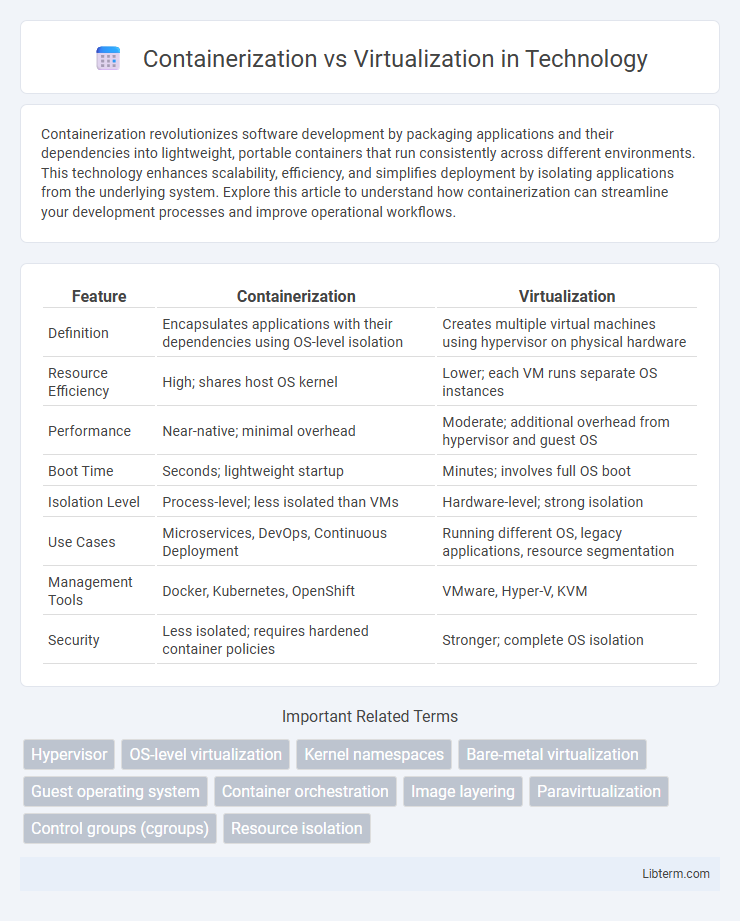Containerization revolutionizes software development by packaging applications and their dependencies into lightweight, portable containers that run consistently across different environments. This technology enhances scalability, efficiency, and simplifies deployment by isolating applications from the underlying system. Explore this article to understand how containerization can streamline your development processes and improve operational workflows.
Table of Comparison
| Feature | Containerization | Virtualization |
|---|---|---|
| Definition | Encapsulates applications with their dependencies using OS-level isolation | Creates multiple virtual machines using hypervisor on physical hardware |
| Resource Efficiency | High; shares host OS kernel | Lower; each VM runs separate OS instances |
| Performance | Near-native; minimal overhead | Moderate; additional overhead from hypervisor and guest OS |
| Boot Time | Seconds; lightweight startup | Minutes; involves full OS boot |
| Isolation Level | Process-level; less isolated than VMs | Hardware-level; strong isolation |
| Use Cases | Microservices, DevOps, Continuous Deployment | Running different OS, legacy applications, resource segmentation |
| Management Tools | Docker, Kubernetes, OpenShift | VMware, Hyper-V, KVM |
| Security | Less isolated; requires hardened container policies | Stronger; complete OS isolation |
Introduction to Containerization and Virtualization
Containerization leverages lightweight, isolated user-space environments called containers, sharing the host OS kernel to run applications efficiently with minimal overhead. Virtualization creates full virtual machines (VMs) with separate OS instances, using hypervisors to abstract hardware resources for complete isolation. Containerization offers faster startup times and better resource utilization compared to traditional virtualization, making it ideal for microservices and cloud-native applications.
Core Concepts: What is Virtualization?
Virtualization is a technology that creates multiple simulated environments or dedicated resources from a single physical hardware system, enabling multiple operating systems to run simultaneously on a single server. It relies on a hypervisor, which abstracts and manages the hardware, allowing virtual machines (VMs) to operate independently with their own OS and applications. Virtualization improves resource utilization, isolation, and scalability by enabling efficient workload consolidation and flexible infrastructure management.
Core Concepts: What is Containerization?
Containerization is a lightweight virtualization method that packages applications and their dependencies into isolated user-space containers on a shared operating system kernel. Unlike traditional virtualization, containers share the host OS, enabling faster startup times, reduced resource usage, and improved portability across different computing environments. Core technologies enabling containerization include Docker, Kubernetes, and container runtimes such as containerd and CRI-O.
Architecture Differences: Containers vs Virtual Machines
Containerization uses lightweight, operating system-level virtualization where multiple containers share the host OS kernel while running isolated user spaces, resulting in faster startup times and efficient resource utilization. Virtual machines (VMs) rely on hardware-level virtualization, each running a full guest operating system on hypervisors, which provides stronger isolation but with higher overhead and longer boot times. Containers package applications and dependencies together, enabling portability across environments, whereas VMs encapsulate entire operating systems, making them suitable for running diverse OS instances on the same physical hardware.
Resource Efficiency and Performance Comparison
Containerization leverages the host operating system's kernel, enabling multiple isolated applications to run efficiently with minimal overhead, which results in faster startup times and lower resource consumption compared to virtualization. Virtualization requires separate guest operating systems for each virtual machine, leading to higher CPU, memory, and storage usage, which can reduce overall system performance. Consequently, containerization offers superior resource efficiency and improved performance, especially in environments where rapid scaling and lightweight deployment are critical.
Security Implications: Containers vs Virtual Machines
Containers share the host OS kernel, which can increase security risks by exposing the system to kernel vulnerabilities, whereas virtual machines (VMs) provide stronger isolation through separate guest OS instances, reducing attack surfaces. Container breakout attacks pose significant threats if an attacker exploits kernel flaws to access the host system, while VMs limit such breaches with hardware-level isolation and hypervisor controls. Implementing robust container security measures, such as runtime security tools and namespace separation, is essential to mitigate risks compared to the inherently more isolated VM environments.
Deployment and Scalability Considerations
Containerization enables rapid deployment by packaging applications with their dependencies in lightweight, portable units, which scale efficiently across diverse environments with minimal overhead. Virtualization involves creating full virtual machines with separate operating systems, resulting in heavier resource consumption that can slow deployment and limit scalability. Container orchestration platforms like Kubernetes enhance scalability by automating container management, whereas virtual machine scaling often requires more complex infrastructure and longer provisioning times.
Use Cases: When to Use Containers or Virtual Machines
Containers excel in microservices and DevOps environments due to their lightweight nature, rapid startup, and efficient resource utilization, making them ideal for continuous integration and deployment workflows. Virtual Machines provide robust isolation and security, making them suitable for running diverse operating systems, legacy applications, and environments requiring strong fault isolation or compliance standards. Choosing between containers and VMs depends on workload requirements, with containers favored for scalability and speed, while VMs are preferred for heavy-duty processing and multi-OS compatibility.
Challenges and Limitations of Each Approach
Containerization faces challenges such as limited isolation compared to virtualization, potential security vulnerabilities due to shared kernels, and compatibility issues with certain legacy applications. Virtualization encounters limitations in resource overhead, slower boot times, and reduced performance efficiency caused by hypervisor layers. Both approaches require careful management of resource allocation and security to optimize deployment in enterprise environments.
Future Trends in Containerization and Virtualization
Advancements in containerization emphasize lightweight, scalable microservices architecture enabling faster deployment and improved resource efficiency compared to traditional virtualization. Future trends predict enhanced integration of Kubernetes with hybrid and multi-cloud environments to optimize container management and orchestration. Virtualization is evolving with hardware-assisted virtualization and increased support for edge computing, promising seamless interoperability between virtual machines and containers for diverse cloud-native applications.
Containerization Infographic

 libterm.com
libterm.com